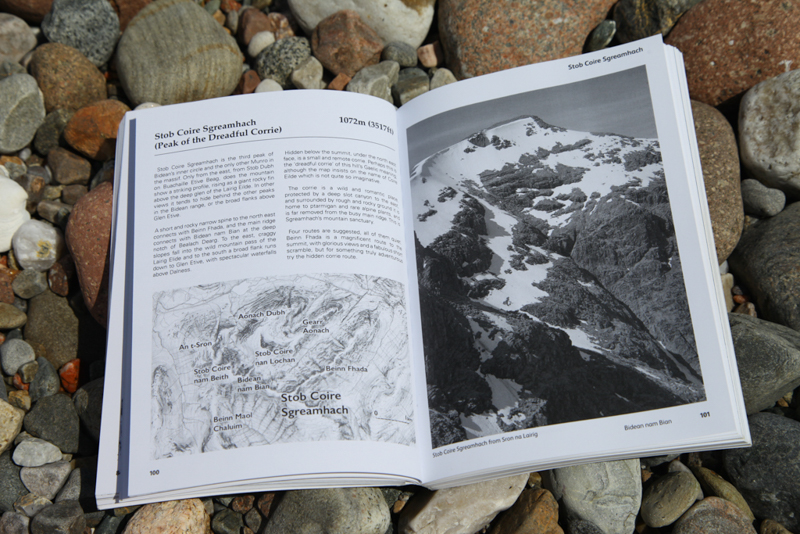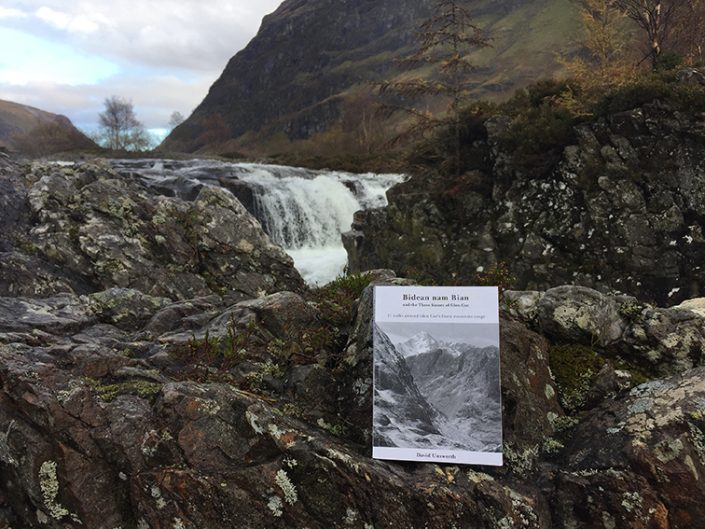Q & A
Excerpt from a recent interview with David about the book
How did you go about finding the routes?
Bidean nam Bian has a plethora of superb routes to the summit. Some are well known but many are not, and traverse some of the most spectacular mountain terrain anywhere in the Scottish highlands. It was these lesser known walks which I wanted to highlight, in particular routes to the summits of the outer peaks such as Aonach Dubh, Beinn Fhada and Gearr Aonach (the three sisters). These mountains are right in the very heart of Glen Coe but are curiously unfrequented as most walkers generally head directly for the summit of Bidean. These outer peaks are both challenging and enjoy superb viewpoints in their own right. Any ascent can easily be extended to include the summit ridge of Bidean.
There are also some fantastic walks through some wonderfully rugged ground. They explore hidden corries, tiptoe under and around some of the mighty rock buttresses of Bidean on tiny climbers tracks, and there are also routes on the quiet side of Bidean above Glen Etive where wildlife abounds. They have a real flavour of gentle mountaineering about them, often weaving over steep or rugged ground by the easiest lines.
The mountain has nine separate summits and each summit has its own chapter. As I was already very familiar with the mountain so many of the routes were already well known but some, and this was the fun part, were not at all. These routes were found by studying maps, scouring old guide books for clues and for some, just being curious and intriguing.
Taking An-t Sron as an example, the ridges were a natural place to start and one, the east ridge, turned out to be an absolute gem. There was a vague reference to it in the Irvine Butterfield guide ‘The High Mountains of Britain and Ireland’ but no reference of how to get onto the ridge from Coire nam Beith or any indication of the ridge above. Clearly this needed investigating, and after an initial steep scrabble it proved to be a fabulous route full of interest and with simply superb views. I have been up and down this ridge half a dozen times now and it has become a firm favourite. Another route on An-t Sron, from Fionn Gleann is entirely of my own making and demonstrates my fondness for fossicking around on steep ground. It introduces the walker to the beautiful Fionn Gleann, another place which really deserves to be better known. Hidden in full view from the road through Glen Coe, this glen is an absolute gem. Full of wild flowers in the spring and early summer and with a beautiful river this is the quiet side of Bidean. The route heads through the lower glen then climbs directly to the ridge between An-t Sron and Stob Coire nam Beith. It is emphatically a walking route but is dramatic and adventurous and finishes with an easy scramble up a wide gully between rock towers.
These are just two examples but they give a flavour of the book’s less widely known routes. Finding the routes was very easy but narrowing them down was a different matter altogether.
How did you narrow the routes down?
My enthusiastic reference gathering had yielded over forty routes. The page count had reached five hundred and the book was in serious danger of needing to be split into two volumes, which would have been rather excessive for a single mountain, even one as complex as Bidean. I needed to do some pruning. The popular and well trodden routes to the summit had to stay in, in fact any route with a path needed to stay in. I chose to discard the routes with a marked sense of exposure, this being a walking guide, so out went the Rhyolite romp and Ossian’s rake due to the exposure, another steep and potentially problematic one on the north east face of Aonach Dubh, a beautiful but steep rocky scramble on the sunny side of Stob Coire nam Beith and several more. The ones which have been included are a perfect mix of popular walks on good footpaths and my pick of the best pathless routes to the summits.
What learnings did you take on board, did you refine the process?
There are so many things I have learnt during the production of this guide book. I had the unique privilege to work on the entire project, cover to cover, producing the text, photographs, illustrations and maps. Of course I was working to a brief but, within those constraints, had free range to pick the routes, the aesthetics of the illustrations and maps and the accompanying photographs. The book became one of the most enjoyable projects I have worked on.
One of the major challenges was linking the text description of the walks to the maps and illustrations. This was achieved by creating a standard template for each route, consisting of a brief introduction then the route with a map, illustration and the text description. Sequential numbering of each stage of the route was marked in the description and also on the map and illustration. I wanted the reader to be able to interact with the guide book in as natural a way as possible. Some would choose the visual aspects of the guide to route find by using the map and illustration alone, some would use the text descriptions and others would use a combination of the three depending on terrain, experience and conditions.
Looking back now I can see how inefficient my working methods were. Many times I would go back to a route just to make sure I had the description absolutely perfect. It was often so very subtle a change which made the difference as I was learning all the time to match my interpretation of salient features on the ground to what others might see standing on the same piece of ground. The book seemed to progress in a very organic way as routes were added, illustrations and photographs made, maps completed, and it was always hugely enjoyable. I’m sure I could have been much more efficient if I had planned meticulously before any field trips, such as matching a route walk with making an illustration for example but time pressures and goals achieved have no place on the hill, at least not for me. If there is to be joy in the book then the process must be a joy. Just the sheer pleasure of walking through these beguiling mountains, spending time sketching views and watching the cloud shadows, or bathing tired feet in the crystal mountain burns at the end of a long day brought such simple happiness. Certainly for the second book I will try to plan ahead a little more, but we shall see.








